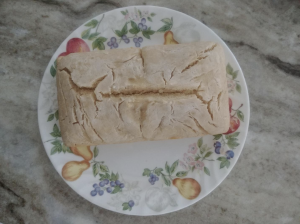
Fermentation and Food Waste
By: Jasmine Lin, Junior in Emory College, Anthropology and Human Biology Major
I would be lying if I said I didn’t try out my own sourdough starter last summer. My starter, a fermented mix of flour and water, had a unique microflora of wild yeast and lactic acid bacteria. The combination of yeast with the lactic acid bacteria is what allows my sourdough bread to rise, have a longer shelf life, and produce the notorious complex sour flavor and texture.

The idea of fermentation may sound revolting or it may be scary in the sense that you fear accidentally poisoning yourself and others. However, common foods like chocolate, cheese, coffee, sour cream, yogurt and miso have all undergone the process of fermentation at some point in their preparation.
There are many different pathways to fermentation, but at its core, fermentation is a “process by which microbes consume sugars and produce acid, alcohol and gases” (The Good Gut 2016). Fermentation has been used for food preservation for thousands of years. Before modern technology like canning and refrigeration, fermentation was the premier technique for low energy preservation.
Now I’ve mentioned that my sourdough starter contained wild yeast and lactic acid bacteria, but how does fermentation actually work?
Fruits and vegetables naturally contain mold, yeast, and bacteria- the elements that lead to food spoilage over time. However, when salt is added, it creates an environment that makes it impossible for the bad, harmful bacteria to live. Additionally, these elements cannot survive in an anaerobic environment. A lack of oxygen in combination with the presence of salt encourages specific microorganisms to flourish and produce the desired acids.
- The first and most common type of fermentation is lactic acid fermentation, a.k.a. lacto-fermentation. Lacto is the nickname for Lactobacillus, the genius bacteria behind foods like yogurt, sourdough, and cheese! During lacto-fermentation, the lactobacillus bacteria convert sugars in the food (glucose) into lactic acid. This acid lowers the pH and helps preserve the food.
- The second type of fermentation is ethanol (alcohol) fermentation. This fermentation is more common in yeasts and involves the breakdown of sugars into ethyl alcohol and carbon dioxide. From this process, we derive the basis for the manufacturing of alcoholic beverages such as wine and beer.
- The last type of fermentation is acetic acid fermentation. During acetic acid fermentation, the acetic acid bacteria can oxidize ethanol to acetic acid which ferments the starches and sugars found in fruits and grains. Common products of acetic acid ferments include kombucha and apple cider vinegar.
Up to 40% of food in the U.S. is never eaten. Limp vegetables are tossed. The best by date labels are passed by. Well-intended leftovers never get eaten. However, fermentation is a great alternative for lowering food waste while having fun and creating new flavors!
While fermentation results in alteration to the traditional taste, texture, color, and smell of the food, it also results in improved nutritional health benefits while preventing food waste and using little to no energy. The best part of fermentation is that you can ferment almost everything!
For a classic fermentation recipe, you can try to make Sauerkraut. All you need is cabbage and salt.
- Thinly slice the cabbage (set one leaf aside), place a layer of cabbage in a bowl, and sprinkle it with 1 tablespoon of salt per cabbage
- Now you can add in other foods like carrots, onions, garlic, or any other vegetable!
- Grab handfuls of your cabbage and squeeze tightly to release juices (keep the juice!)
- Let the cabbage rest for about one-two hours
- Pack the cabbage into a clean jar and shove it down so that it is always submerged in the juice from earlier
- Close the lid (but not completely/tightly), place in a cool location, and now you wait!
- You can try the sauerkraut after 3 days for taste and then transfer to the refrigerator for storage.
If you would like to learn more about fermentation, a great source is The Art of Fermentation: An In-Depth Exploration of Essential Concepts and Processes from Around the World by Sandor Katz. Also, one of my favorite YouTubers, Joshua Weissman, has a channel featuring fermentation Fridays through which he explores different methods of fermentation every Friday!
Thanks for reading – if you have tried fermentation yourself please comment below!
Works Cited:
Chef, The Zero-Waste. “Sauerkraut – Zero-Waste Chef.” Zero Waste Chef, 29 Mar. 2014, zerowastechef.com/2014/03/29/sauerkraut/.
Sonnenburg, Justin, and Erica Sonnenburg. The Good Gut: Taking Control of Your Weight, Your Mood, and Your Long-Term Health. Penguin Books, 2016.
Featured Picture (Thumbnail):
https://he.utexas.edu/ntr-news-list/lets-talk-about-fermentation
